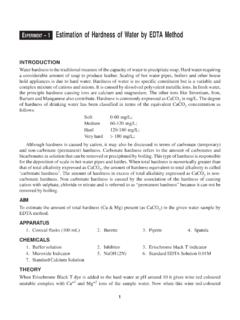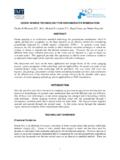Transcription of C HAPTER 1 INTRODUCTION TO …
1 CHAPTER 1 INTRODUCTION TO PHARMACEUTICAL inorganic CHEMISTRY PHARMACEUTICAL CHEMISTRY Pharmaceutical Chemistry is a branch of chemistry that deals with the chemical, biochemical and pharmacological aspects of drugs. It includes synthesis/isolation, identification, structural elucidation, structural modification, Structural Activity Relationship (SAR) studies, study of the chemical characteristics, biochemical changes after drug administration and their pharmacological effects. inorganic Chemistry inorganic chemistry is the study of all the elements and their compounds except carbon and its compounds (which is studied under organic chemistry). inorganic chemistry describes the characteristics of substances such as nonliving matter and minerals which are found in the earth except the class of organic compounds.
2 Branches of inorganic chemistry include coordination chemistry, bioinorganic chemistry, organometallic compounds and synthetic inorganic chemistry. The distinction between the organic and inorganic are not absolute, and there is much overlap, especially in the organometallic chemistry, which has applications in every aspect of the pharmacy, chemical industry including catalysis in drug synthesis, pigments, surfactants and agriculture. In short, inorganic chemistry is the branch of chemistry that deals with inorganic compounds. In other words, it is the chemistry of compounds that do not contain hydrocarbon radicals. inorganic Compounds These are traditionally viewed as compounds being synthesized by the geological systems and lack hydrocarbon (carbon-hydrogen). In contrast, organic compounds are those found in biological systems.
3 In general organic chemists say any molecule containing carbon as an organic compound and hence this means that inorganic chemistry deals with the compounds or molecules which lack carbon atom. Berzelius, the 19th century chemist, described inorganic compounds as inanimate. The first important synthetic inorganic compound was 1 2 PHARMACEUTICAL inorganic CHEMISTRY ammonium nitrate for soil fertilization. inorganic compounds are found in nature as minerals. Soil contain iron sulfide as pyrite or calcium sulfate as gypsum. They are also found multitasking as biomolecules: As electrolytes (sodium chloride), in energy storage (ATP) or in construction (the polyphosphate backbone in DNA). inorganic compounds are synthesized for use as drugs such as cisplatin, magnesium hydroxide, catalysts such as vanadium (V) oxide and titanium (III) chloride, or as reagents in organic chemistry such as lithium aluminium hydride.
4 Medicinally useful substances are derived from either organic or inorganic sources. Naturally obtained compounds attracted the attention of humans always, in which inorganic chemicals contributing significantly in some of the ailments, even after the development of many drugs from synthetic and plant sources. Many of the inorganic salts (antimony, arsenic and mercury) are known to be poison, still they are used in medicine cautiously. Some of them are replaced by the organic medicines. Study of pharmaceutical applications of the inorganic compounds led to the establishment of a new avenue called Pharmaceutical inorganic chemistry, which deals with the study of both non-essential and essential elements about their preparation, standards of purity, test for identification, limit tests to be performed for determining the quality and extent of purity, storage, different formulations and their storage conditions and therapeutic uses.
5 The term Pharmaceutical is used for any chemical substance useful in preventive or therapeutic or which finds use in the preparation of medicament. Some find use only in the laboratory during the preparation but may not be present in the final product, these are also incorporated under pharmaceuticals. Quality of all these pharmaceuticals must be carefully controlled. For this reason specifications of quality are mentioned for each pharmaceutical. These descriptions are reported in the pharmacopoeia. Importance of inorganic Pharmaceuticals inorganic pharmaceuticals are useful in any of the following ways. 1. Useful medicinally for their therapeutic purpose. Example: Astringents and antimicrobials etc. 2. Useful as pharmaceutical aids. Example: Bentonite, talc etc.
6 3. To change the reaction of body fluid. To acidify or alkalise. Example: Antacids, alkalis, mineral acids. 4. Replacing or replenishing the normal content of body fluids. Example: Sodium, potassium, calcium, chloride, phosphate etc. 5. Useful as reagents to carry out the reactions. Example: Catalysts (platinum, nickel) oxidizing and reducing agents (lithium aluminium hydride). 6. Useful in Pharmaceutical analysis. Example: Titrants such as potassium permanganate etc. CHAPTER 1 INTRODUCTION TO PHARMACEUTICAL inorganic CHEMISTRY 3 Various uses of inorganic pharmaceuticals in pharmacy are presented herein Abrasives: Drugs which are used for the cleaning and whitening of teeth. Example: Dibasic calcium phosphate. Absorbents: Drugs which are used to absorb the toxins and bacteria in the GIT.
7 Example: Calcium carbonate. Acidifiers: Drugs which are used to enhance the acidity temporarily in GIT. Example: Dilute hydrochloric acid. Adsorbents: Drugs which are used in the treatment of mild dysentery or diarrhoea or other disturbances of GIT due to their ability to adsorb gases, toxins, and bacteria. Example: Bismuth subcarbonate, Bismuth subnitrate. Alkalizers: Drugs which are used to induce the alkaline condition or used in acidic condition of body. Example: Sodium citrate. Anaesthetics: Drugs which are used to produce reversible loss of sensation. Example: Nitrous oxide. Analgesic: Drugs which are used to relieve pain. Example: Nitrous oxide. Antacids: These are drugs which are usually alkaline substances, used for neutralizing excess acid in the stomach. Example: Aluminium hydroxide gel, Calcium carbonate, Magnesium carbonate.
8 Anthelmintics: Compounds used for the treatment of worm infestations or schistosomiasis. Example: Ammoniated mercury, Sodium antimony tartarate. Antibacterial: Drugs which are used in the treatment of bacterial infections. Example: Yellow mercuric oxide (ophthalmic). Anticonvulsants: Drugs which are used for the treatment of epilepsy. Example: Potassium bromide. Anti coagulants: Drugs which are used to prevent blood clotting. Example: Sodium citrate. Anti depressants: Drugs which are used in the treatment of depression. Example: Lithium carbonate. Antidotes: Drugs which are used in the treatment of poison. Example: Sodium nitrite, Sodium thiosulphate. Antifebriles: Drugs which are used to relieve pain or reduce fever.
9 Example: Ammonium acetate. Antifungal agents: Drugs which are used in the treatment of fungal infections. Example: Zinc undecylenate (topical use), Potassium iodide. Antihypercalcemic agents: Drugs which are used in the treatment of abnormal calcium concentration in the body. Example: Sodium acid phosphate. Anti infectives: Drugs which are used in the treatment of local infections. Example: Potassium permanganate, Silver nitrate, Hydrogen peroxide, Boric acid. 4 PHARMACEUTICAL inorganic CHEMISTRY Anti inflammatory agents: Drugs which are used in the treatment of inflammatory pain (Rheumatoid arthritis). Example: Sodium aurothiomalate. Anti irritant agents: Drugs which are used to prevent irritation or allergic reactions. Example: Aluminium metal powder. Antiseptics: Drugs which are used to inhibit the growth and development of micro organism without killing.
10 Example: Strong iodine solution. Antiperspirants: Drugs which are used to remove the bad odour in body. Example: Aluminium sulphate. Anti-protozoals: Drugs which are used in the treatment of protozoal infections or Leishmaniasis. Example: Sodium antimony gluconate. Anti pruritics (topical): Drugs which are used in the production of soothing effect in the skin. Example: Calamine. Anti rheumatics: Drugs which are used in the treatment of rheumatism. Example: Sodium aurothiomalate. Anti thyroids: Drugs which are used in the treatment of thyrotoxicosis. Example: Potassium perchlorate. Anti tumor agents: Drugs which are used in the treatment of cancer. Example: Cisplatin (Testicular and ovarian cancer). Anti schistosomal agents: Drugs which are used in the treatment of schistosomiasis.











